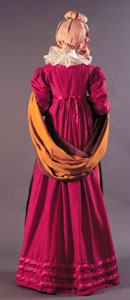 |
| 1899 jacket |
Winter Magic is our Blue Mountains winter solstice festival and dressing up is an essential element of the day.
I've made my bustle skirt already, I used this fabulous tutorial The Incredibly Easy Bustle Skirt, as always, I adapted the method and the look and I intend to do a post about it after Winter Magic.
This year, my inspiration was a European jacket from 1899 which shows the very heavy military influence in women’s clothing during the last few years of the 19th century, perfect for my SteamPunk personna.
I used my Laughing Moon Saloon Girl jacket pattern as the base for my adaptation. I've made the pattern up before, it works well, fits well and goes together quickly. The jacket is boned which means it sits well and I won't need a corset if I choose not to wear one.
This is another stash project and I found the most beautiful black wool hiding there, Georgio Armani no less! I bought it from Tessutti's bargain table a few years back, its perfect for the project. The lining is a shot green silk I found in a second hand shop. The photo doesn't do justice to either I'm afraid.
The original Laughing Moon pattern has a low neckline and three quarter sleeves, I adapted it to accommodate a Mandarin collar and lengthened the sleeves. The jacket will be black with red braid and details.
First stage:
I cut out the three fabrics, wool, silk and cotton interlining and stitched all together. Its great not to have to fit the jacket as the pattern adaptations were made last time I made it up, that really helps in a 'quick-quick' project like this.
I interlined the black wool to give it more body as the fabric has such a soft hand, a bit of a shame I know, but I wanted the jacket to have the military stiffness of much heavier wool.
The project came to a stop as I had no boning or braid in my stash.
Stage two:
The Queen's Birthday long weekend and gave me a chance to get on with my project.
I added the boning channels and inserted my cable tie 'bones'. Steel is recommended in the pattern but I find them too unforgiving and prefer the whale 'bone' feel of cable ties.
I eased in the sleeves in both jacket and and lining, added shoulder pads to give a more military feel and then stitched in the lining.
I wanted a high military style collar so drafted one up and tested it with a toile and it worked very well, most pleased. This will be in scarlet wool, along with the sleeve cuffs.
The Georgio Armani wool was beautiful to stitch and has a glorious sheen, the photos do not do it justice.
I wanted to wear this jacket to Winter Magic, I had the collar to add, fastenings and the braiding to 'pimp' it up.
Final stage: Pimp up
Front before pimping
Back before pimping
I was going to use braid to decorate the jacket, but that meant a trip to the shops and the weather was dull and very wet, so did not leave home.
I used the red wool to make trim for the jacket, I think it works well and gives the 'uniform' feel that I was after and the gold sun buttons look well against both red and black.
Unfortunately I have gained a bit of weight since I last made this pattern up and closing the jacket is a tad difficult. So, I replaced the smaller black placket which is meant to be hidden, with a much wider red one that displays down the front, and that did the trick!
I hand stitched down all the trims and the jacket was finished for Winter Magic.
 |
| Sam on the left and me on the right, I should have worn my corset! |




















































